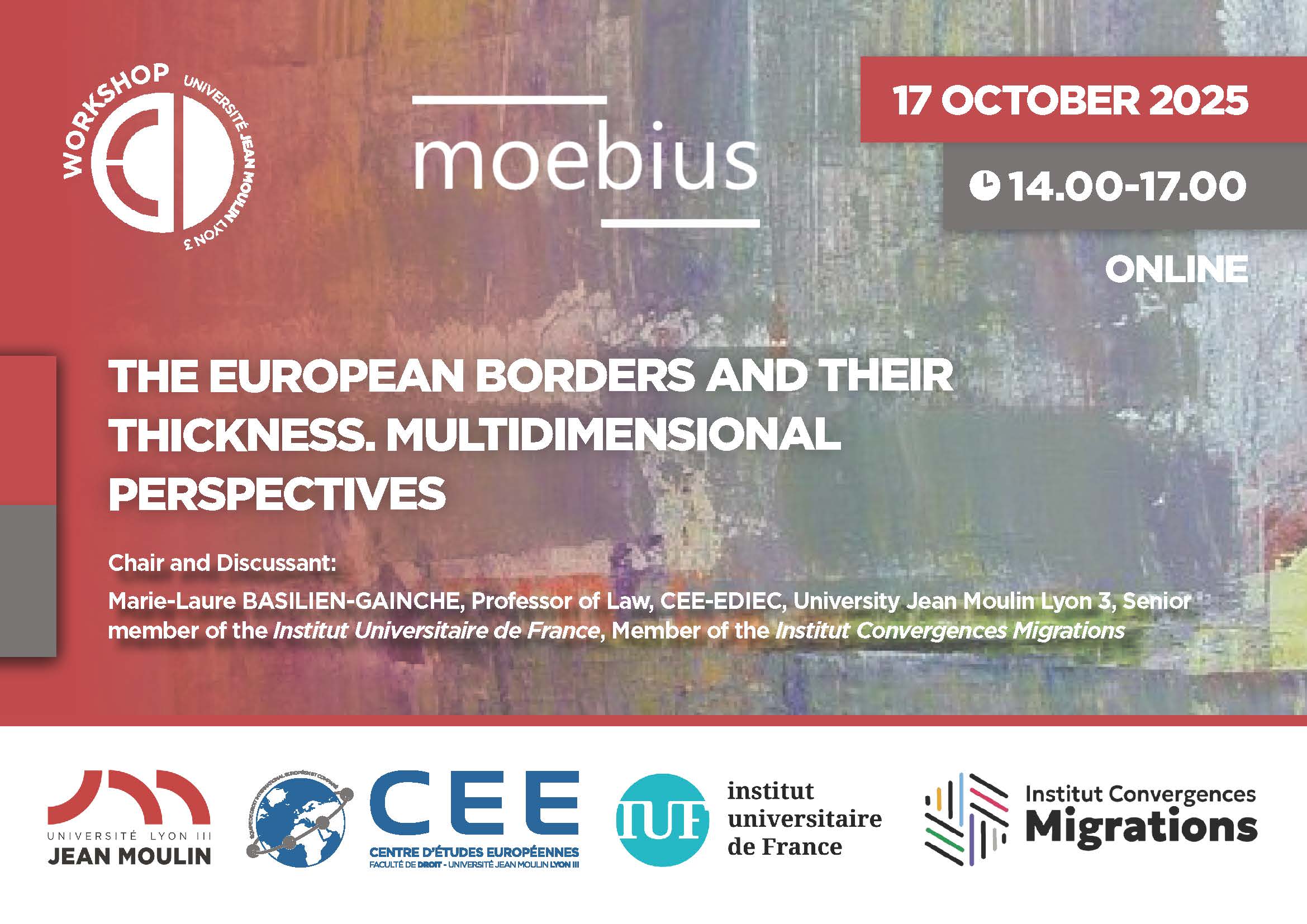- Droit,
- Recherche,
- International,
Workshop MOEBIUS – The European Border and their Thickness. Multidimensional Perspectives

Chair and Discussant : Marie-Laure BASILIEN-GAINCHE, Professor of Law, CEE-EDIEC, University Jean Moulin Lyon 3, Senior member of the Institut Universitaire de France, Member of the Institut Convergences Migrations
Abstract
If the thickness of borders has been studied widely by geographers who underscore that they are not any more one dimensional line between dyads but from now on multi-dimensional areas opposed to migrants, the idea has not been fully exploited by other disciplines. This is the purpose of this panel that will create discussions between sociology, political science and law on the matter. Diverse approaches will consider the width of EU external borders that expand their borders outside the territory (externalisation) and extend them inside their territory (internalisation); that constitute large spatial spaces (which unfold migrants in networks beyond and below the territorial State limits) and long temporal phases (which impose an
immersion of migrants in a temporality that is both dilated and suspended). In order to seize the consequences of the fact that borders and territory are decoupled, the material thickness of EU borders will be explored. This one is due to the legal norms that organise the deployment of border control and migration management beyond and below the contours of the states’ territory; to the multiple actors that occupy these spaces-times (migrants, state authorities, international organizations, non-governmental organizations, private for-profit actors, and so forth); to the diverse categories migrants are assigned to that determine the set of rights they can have access to; to the multiplication of the exceptions states can activate to
evade general norms for instance on the ground of migrants’ instrumentalisation. These perspectives will thus analyse the dense and varied fabric borders are.
- REDEFINING THE LEGAL GEOGRAPHY OF EU BORDERS
-
Giuseppe CAMPESI, Professor in law and society, University of Bari (Italy)
The presentation will delve into how policies regulating human mobility involve a genuine manipulation of the legal morphology of EU borders. Using critical analysis tools of legal geography, it will trace the evolution of EU border control
policies, culminating in the most recent measures included in the so-called EU Pact on Migration and Asylum. It will illustrate how the evolution of EU border control policies has given rise to the emergence of three different geostrategic
models for controlling mobility. The geostrategies of nodes, zones, and walls. In describing the new legal geography of borders, the intervention also highlights how the transformations and shifts of the classic Westphalian border regime have an
impact on some of the main categories through which borders are legally framed. In particular, on the category of jurisdiction, which traditionally represents the point convergence of the complex relationship between territory, sovereignty and
rights. - THE THICKNESS OF EXTERNALIZED EU-ROPEAN BORDERS: THE CENTRAL MEDITERRANEAN CONTEXT
-
Paolo CUTTITTA, Sociologist, researcher at DISFOR, Università di Genova & associated researcher at IDPS, Université Sorbonne Paris Nord
Present-day state borders are thick for at least two reasons and in at least two different ways. First, state authorities internalize and externalize their borders, by directly or indirectly operating control inside and outside the official demarcation
line of their territorial borders: the thickness of externalized EU-ropean borders in the Central Mediterranean region, including the Strait of Sicily and North Africa, refers to the spatial extension, that is to the two-dimensionality of actual
borders as opposed to official, one-dimensional border lines. Second, borders are densely populated by different actors: migrants, state authorities, international organizations, non-governmental organizations, private for-profit actors, armed
groups, etc.: this thickness refers to the materiality of borders, to their dense and varied fabric. These two dimensions of the borders thickness are intertwined: the material thickness of the borders’ fabric is also made of the overlapping legal
regimes that result from the spatial thickness of the border. Yet in the terrestrial and maritime environments of the Central Mediterranean and of the territories of North African countries, European borders thickness poses sovereignty issues the
paper will expose and analyse. - RETHINKING EU BORDERS BEYOND TERRITORY: THE EMPIRE OF CATEGORISATION
-
Maria GKEGKA, PhD in Law, researcher at University Paris Nanterre & teaching assistant at Paris 1 Panthéon-Sorbonne University
EU borders are generally thought of in a territorial logic, they delimitate space on a double level. Internal borders between Member States tend to blur, while external EU borders are being reinforced. What this paper argues, however, is that we are witnessing a paradigm shift nowadays. On the one hand, the dichotomy between “insiders”/“outsiders” appears blurred as legal categories of migrants proliferate. On the other hand, new borders, fully dematerialised, are emerging. The two
elements are intertwined: there is a move from the spatial dimension of EU borders to a personal dimension through the legal technique of categorisation of migrants. If any border generally draws an inside and an outside, legal categorisation creates demarcation lines for migrants in numerous and variable areas: categories serve to delimit not only the territory – entry, stay, removal, intra-European mobility – but also essential aspects of human life – family development, social protection, access to job. They operate like personal boundaries, which are as much vectors of inclusion and exclusion. Thus, legal categorisation broadens the line of borders and extends control. - EU BORDERS AS (DE)HUMANI(TARIANI)ZATION
-
Violeta MORENO-LAX, Professor of Law, Queen Mary University of London & University of Barcelona
EU border management has long been securitized and humanitarianized (Vaughn-Williams 2015; Pallister-Wilkins 2017), with prevailing characterizations paying attention to the urgency of crises and emergencies, concentrating on the “here
and now” of shipwrecks and similar “catastrophes”. The place of the agency, dignity and rights of people on the move has been diluted and displaced to a second plane. The gap between declared principles and the practical-political
constraints to which the EU is confronted has been theorised as a case of “organised hypocrisy” (Lavenex 2018), with the so-called “capabilities-expectations gap” considered a by-product of attempts at reconciling conflicting demands imposed
by the contradicting normative and technical environments within which the EU operates. What this paper argues, however, is that developments at EU borders should, instead, be apprehended as a case of “structured dehumanization”,
whereby the gap between discourse and action is progressively closing. But rather than approaching law to principle and redressing malpractices, this is achieved by attempting a reformulation of the relevant rules that dismantles underlying values. The “anti-instrumentalization” package illustrates this move. It is not only that the disconnection between migrants’ rights and realities is augmented. The antiinstrumentalization reforms openly entrench hostility and violence through the
legalization of violations (framed as permissible “exceptions” from the supposed general norms whose application is rendered near-impossible). The gap between rhetoric and practice is thus closed, but at the cost of EU values and founding
principles, inaugurating a new era of overt contempt that objectifies (unwanted) migrants and negates their full personhood.

Informations
Distanciel
